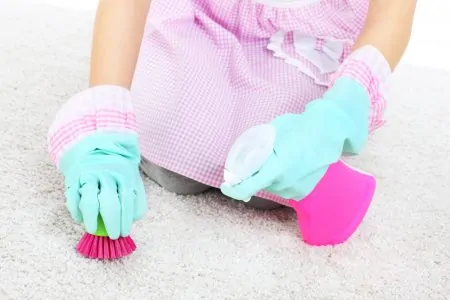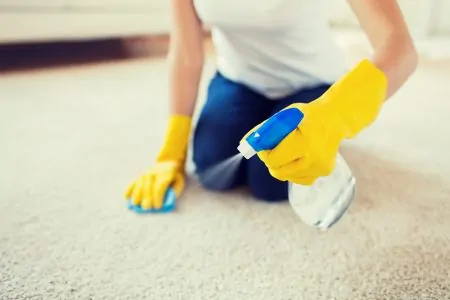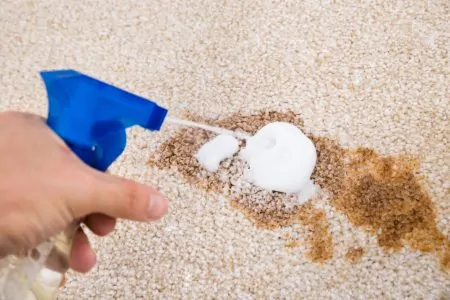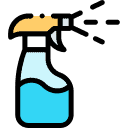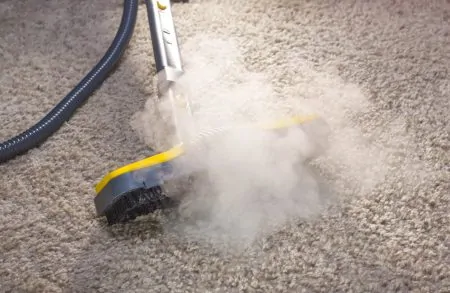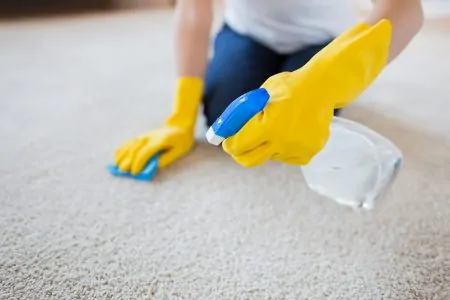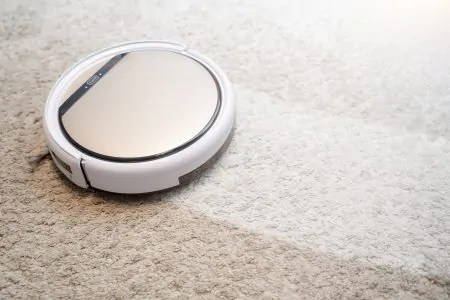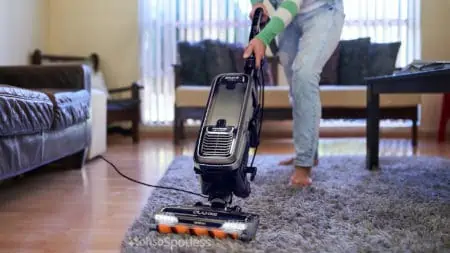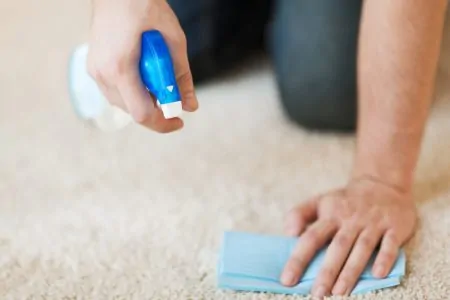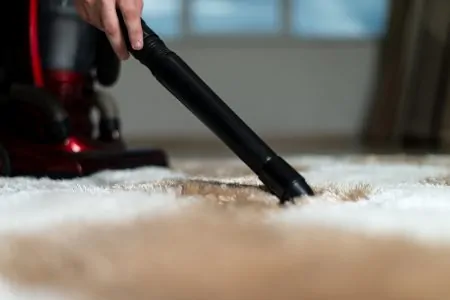Are you beginning to experience allergy-like symptoms? Or maybe you’re having more asthma attacks than usual? It could be due to mold in your carpet.
Mold in a carpet isn’t always visible; it could be growing inside the carpet pad, which can be tricky to detect. Sometimes it even grows in the fibers.
Either way, it’s essential to kill and remove mold. You might be feeling lost already, but we’re here to help with our ultimate guide on how to clean mold from carpets.
Key Takeaways
- Carpet mold can be dangerous, causing respiratory issues and aggravating asthma symptoms.
- Identify carpet mold by looking for visible growth, mildew, water damage, stains, and odors.
- Remove mold from carpet naturally using baking soda, vinegar, and proper ventilation.
- Prevent future carpet mold by increasing ventilation, using a dehumidifier, and treating sources of moisture.
Is Carpet Mold Dangerous?
Mold is a natural fungus that can grow indoors and outdoors. But it can be dangerous for your health when inside.
Mold exposure can cause various effects on your health — or none. Some people won’t be affected, whereas others can experience severe reactions. People with mold allergies or compromised immune systems can even develop internal infections.
A 2004 study by the Institute of Medicine showed sufficient evidence linking mold to respiratory tract symptoms. This included coughing and wheezing in otherwise healthy people. It also showed an increase in asthma attacks in individuals already with asthma (1).
Carpet mold is hazardous because we’re exposed to it frequently. If the affected carpet is in the living room or bedroom, our health is at even greater risk — especially from chemical reactions in mold cells (2).
How to Identify Carpet Mold
Mold isn’t always visible on the carpet’s surface, so you have to rely on other signs. These include:
- Visible mold growth: Mold prefers a dark environment, but it can grow on the fibers in severe cases. So, look underneath the carpet when you’re inspecting for mold — and don’t forget to check the padding.
- Mildew in carpet: Mildew is often the start of a mold problem. The easiest way to tell the two apart is the color. Mold is black, blue, red, or green — whereas mildew is white, gray, or yellow.
- Water damage: Mold will begin to grow within 24 to 48 hours of being exposed to water, so you have to act fast.
- Stains and odors: Common odors that point to mold are musty, foul, and sour smells. Stains or discolorations could also mean mold. To know for sure, though, you can get professionals to do a sample test (3).
Don’t despair! Luckily, there are ways to get your carpet back to life. We’ll show you a few in this guide.
How to Remove Mold from Carpet Naturally
That’s right, removing mold from your carpet doesn’t necessarily have to involve harsh chemicals. If you have children or pets, this could be the best choice for you. All you need is baking soda, vinegar, and ventilation.
- Time: 20 minutes (plus waiting and drying time)
- Difficulty: Easy
What You’ll Need
- Fan or dehumidifier (optional)
- Baking soda
- Distilled white vinegar
- Spray bottle
- Stiff-bristled brush
1. Inspect Your Carpet
Use the guide above to determine whether or not you have mold. Then inspect further to see where the mold is. Is it in the fibers? In the padding? Check the whole carpet to make sure you locate every possible source of mold.
2. Ventilation is Key
For mold to grow, it needs darkness, moisture, and warmth. So, opening up a window or turning on a fan can reduce the humidity in the room. This will also reduce the effects, such as the unpleasant odor.
3. Sprinkle with Baking Soda
One of the critical things mold needs to grow is moisture. It is, therefore, crucial to eliminate this factor.
Baking soda is incredibly effective at absorbing moisture and reducing odors (4). Use a generous amount on the affected area and leave it overnight. The next morning, use a vacuum to remove the baking soda.
Cat litter is also highly effective at absorbing liquids, so you can use this as a substitute.
4. Finish off with Vinegar
Vinegar is a universal product that can be used for many things — including removing mold stains. It won’t kill every species of mold, but it will remove it. Using vinegar is also a cheap and healthy option for chemicals.
Be Careful
Fill a spray bottle with pure vinegar and arm yourself with a stiff brush. Apply a light coat of vinegar and scrub. Finish off with a blow dryer or fan to get the moisture out.
How to Clean Mold from Carpet Using Chemicals
If you want an effective way to kill mold for good, you must use chemicals. You might even resort to professional help if you feel that it’s needed.
Start by treating your carpet using steps one, two, and three from above. Then try out one of the following methods:
Use an Anti-Mold Treatment
You can find anti-mold cleaners at most supply and hardware stores. There’s also a wide range of choices available on sites like Amazon and Home Depot.
When choosing a product, find one that’s safe for carpets. A product meant for kitchens or bathrooms could damage or discolor carpet.
One of our favorite products is the Duo Blast from Concrobium. It consists of two formulas that work effectively at removing mold, mildew, and the stains they leave behind.
If your carpet is in a close location and you want to prevent future mold, you can find special products. These are called “encapsulates” or “mold-barrier.” They’re designed to leave a thin layer on the carpet, preventing mold from settling.
You can also create your own mold-blasting solution using bleach and water. Mix half a cup of color-safe bleach in a gallon of water.
Test It
Use the anti-mold treatment as directed in the instructions. Bleach shouldn’t be left on the stain for more than a couple of minutes. Use a stiff brush to scrub and blot it out — repeat as necessary.
Carpet Cleaning Product
Carpet cleaners can be highly effective at removing stains and odors left by mold and mildew. These are available at any home improvement, hardware, or supply store. You can also find a wide selection on Amazon and Home Depot.
However, before deciding on a product, make sure it’s safe for your carpet. Carpets aren’t all alike, so you should check this. You can easily find the information in the product description or on the label.
One carpet cleaner we like is the ZEP High-Traffic Carpet Cleaner. It uses enzymes to break down stains and odors.
Use the cleaner according to the instructions provided. Some products have to sit for a while, and others may need rinsing at the end.
Apply Chlorine Dioxide
Chlorine dioxide is very effective at removing mold. It’s also commonly used in mold cleaners. However, use it with caution because the chemicals can discolor the carpet.
Warning
We highly suggest that you test it out in a small area before using it. Do so according to the instructions and allow the spot to dry totally before making a judgment. Some products require the use of a wet/dry vacuum to remove at the end.
Rent a Steam Cleaner
The high temperatures a steam cleaner produces can effectively kill and remove mold. If you don’t have a steam cleaner at home, you can rent one from your local hardware store.
Use a blow dryer or fan after steaming the carpet. Excess moisture can encourage new mold to form.
Keep In Mind
Leave It to the Professionals
If you’re feeling out of your depth, calling in some professional help might be best. Professional carpet cleaners will know how to identify the mold in your carpet and treat it. They also have access to the right equipment and chemicals to kill the mold from the source.
Professionals often use dry ice blasting. This method consists of a pressurized machine that applies the solid form of carbon dioxide — dry ice — to the area.
If You're Out Of Options
If you’ve tried the above methods and still see signs of mold, there’s not much more you can do. The mold has likely infected the whole carpet, and you’ll have to discard it.
Before cutting the carpet, measure out an additional 12 inches on all sides (6). This will ensure all mold is gone.
How to Prevent Carpet Mold
The best way to treat mold is to prevent it in the first place. Use the following tips to avoid future mold:
1. Increase Ventilation
Increasing ventilation throughout your home can help to keep mold and mildew at bay. Work a fan in a carpeted room or air-out by opening the windows during the day. We highly recommend that you do this for at least two hours during the day.
Mind The Weather
2. Use a Dehumidifier
A dehumidifier is an excellent way to control a humid environment. Place the device facing the carpet to keep it dry. It’s also good to run it at night to remove any moisture from the air.
After cleaning the carpet, you can place a fan beside the dehumidifier to blow dry air across the carpet.
3. Treat Sources of Moisture
You should treat spaces prone to dampness. Small areas between the carpet and floor could benefit from an anti-moisture polyethylene sheeting. This will keep the area dry since the plastic blocks out water (7).
You should also check vents, upholstery, and closets for mold. Spores can easily spread throughout a home.
4. Vacuum
Although you may have gotten rid of the growing mold, there could still be spores present within the fibers. By vacuuming regularly, you can keep mold at bay.
A HEPA-filtered vacuum is highly effective when removing a large colony of mold. These use a specialized vent that traps tiny particles and prevents them from entering the air. A good vacuum with a HEPA filter is the Shark Navigator Upright Vacuum — it catches 99.9 percent of allergens.
FAQs
Stay Safe
Mold and mildew shouldn’t be taken lightly. These fungi can cause serious health issues, especially in individuals with a weakened immune system. Carpets are prone to mold due to the thick fibers and the warm and dark environment.
Always inspect both sides of your carpet when looking for mold — any discoloration could be a sign. Mold is usually black, green, blue, or red — mildew is white, gray, or yellow. Use our guide on how to clean mold from carpet to get rid of the problem successfully.
When in doubt, call in a professional to help.
